How to choose heating radiators: types and characteristics
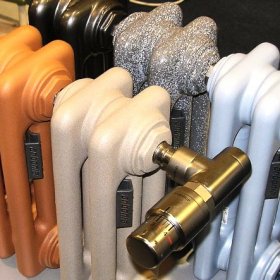
An important link in any heating system is the radiator, which is installed in each of the heated rooms. It is this device that is responsible for how comfortable living conditions will be created in your apartment or private house.
Unfortunately, not every sales assistant will provide you with adequate assistance in choosing, so let's deal with it sequentially: how to approach the choice of a heating battery so that it warms well, looks beautiful and does not “bite” at a price? So immediately answer this question is not easy - it is necessary to take into account many nuances. We will tell you how to avoid major mistakes.
Content
Comparative characteristics of radiators
In the market of heating equipment, heating radiators are represented by products that differ from each other both structurally and by production materials. When choosing them, you can use the table of comparative characteristics of the most popular heating appliances. The manufacturer indicates the data for a specific model in the technical data sheet.
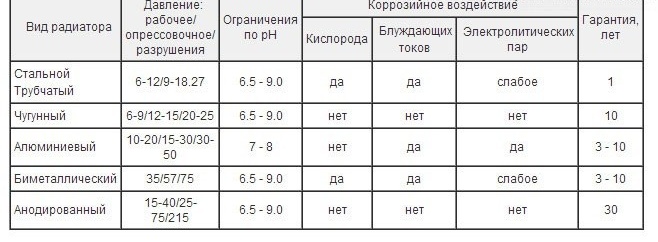
Comparison table of modern heating radiators
Very often, when choosing, the main criterion is the price and appearance. Undoubtedly, these points are very important. And yet, they should not be decisive. First of all, attention should be paid to compatibility with the heating system in such parameters as maximum pressure and type of heat carrier. No less important is the corrosion resistance and durability of the radiator. Ultimately, the right choice will save you money, time and nerves. Next, consider the features of each type.
Cast Iron Radiators
Cast iron batteries For more than 100 years, they have been used in heating systems for housing and, until now, not a single type of heating devices has exceeded them in corrosion resistance and durability. Possessing high heat dissipation, cast-iron “accordions” are perfectly suited for operation in the open spaces of the former CIS.
In the event of an emergency shutdown of heat supply, the “pig iron” will for a long time store the accumulated heat in itself and continue to heat the air. He’s not afraid of critical pressure drops, water hammer and poor heat carrier quality. Hard alkaline water with traffic jams and rust particles do not have such a detrimental effect on cast iron batteries as on other heating appliances, and their price is much lower.All these advantages still encourage many of our fellow citizens to purchase these radiators as heating appliances.
The disadvantages are the inexpressive design, cumbersomeness and high inertia, due to which they cannot be used in modern heating systems with thermoregulation. But in the modern interpretation, thermal appliances have become more stylish and attractive, leaving with them amazing strength and durability.
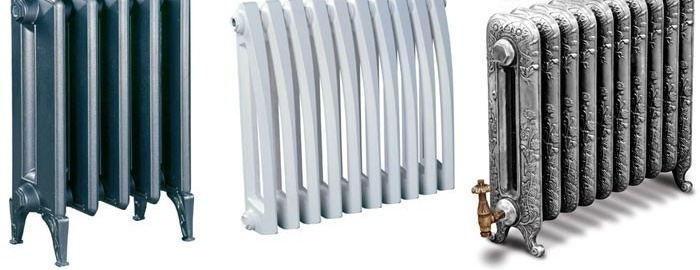
Unlike bulky "harmonica" of the Soviet era, modern cast-iron radiators are an example of design and style. As for the exclusive models, many of them can be attributed to works of art.
Having familiarized yourself with the technical characteristics and other features of modern cast-iron radiators, you will no longer be able to drop them from the scales when choosing.

Summary table of cast iron radiators
The average life is 35-40 years, in reality, many radiators have been working since the 50s of the last century. Calling the shortcomings of cast iron heaters, everyone recalls the bulkiness and heavy weight, completely forgetting about the high thermal inertia. But the last factor is very important, given the general tendency to save heat, and, as a consequence, the use of thermostatic flow controllers in heating circuits.
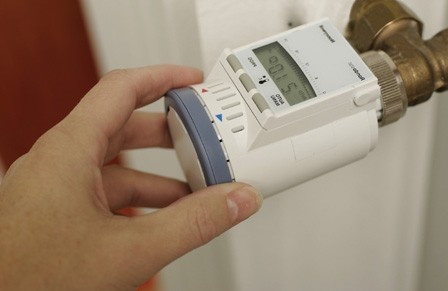
In conjunction with a cast-iron radiator, even the most high-tech temperature regulator will not be able to work - the high thermal inertia of the heater
Aluminum radiators
Unlike cast iron batteries, aluminum radiators have minimal thermal inertia, so are best suited for sharing with temperature controllers.
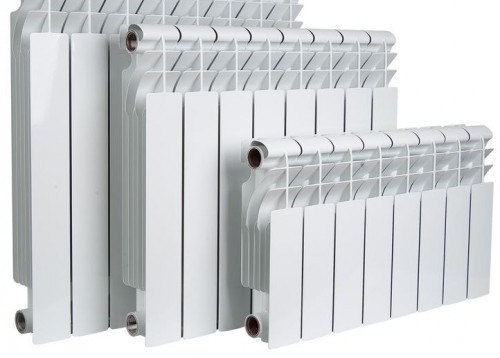
Aluminum radiators stand out with a stylish, interesting design, and during operation do not require special care
High heat dissipation combined with low weight, convenient sectional design and excellent performance. Given that these factors are complemented by ease of installation and elegant design, it is easy to understand the reasons for the popularity of products from aluminum alloys in the arrangement of individual heating systems.
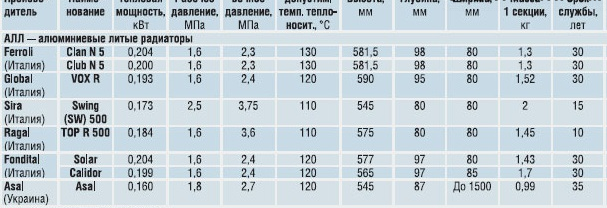
Comparison table of aluminum heating radiators of the most popular brands
Choosing an aluminum radiator, one should not forget that such equipment puts forward higher demands on the quality of the coolant (water). Water with a high alkali content causes corrosion of the metal, and chemical reactions that occur during this process lead to gas formation. As a result, the life of radiators is reduced and the risk of intersectional increases leaks. For this reason, cheap Chinese-made products should be abandoned in favor of products from well-known European manufacturers.
The probability of intersectional leaks is virtually nullified in the design of aluminum radiators from the STOUT brand. The equipment is manufactured at the Italian factory GLOBAL, heating appliances adapted to the operating conditions. The working pressure of each radiator is 16 atmospheres, they are suitable for working with antifreeze and have a 10 year warranty from the manufacturer. Modern design in Italian traditions will fit into any interior, and the increased area of heat radiation will increase comfort in the room.
According to statistics, aluminum radiators have almost the same service life as steel ones - no more than 25 years, while bimetallic batteries can be used for 30-35 years, and cast iron products can easily survive a half-century.
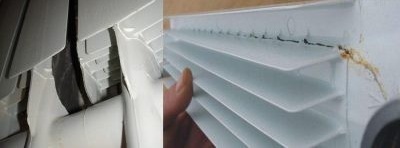
The destruction of aluminum radiators is most often due to poor water quality and excess pressure in the system
Steel radiators
Like other heating equipment with open welds, steel radiators require stable coolant pressure. For this reason, they are most often used for installation in private homes and other buildings with autonomous heating. In this case, the closed heating circuit helps to slow down the oxidation processes, in addition individual heating does not suffer from constant contamination of the coolant with alkali and other aggressive impurities. When using purified water and regular monitoring of pressure, steel radiators do not require replacement for 20 years or more.

Technical characteristics of steel radiators of famous European manufacturers
When installing steel radiators in buildings with central heating, one should be aware of the dangers of water hammer and low quality coolant. Sudden pressure drops and water with impurities of salts and alkalis reduce battery life by more than half. In this case, you should not count on the service life of the equipment more than 10 years.
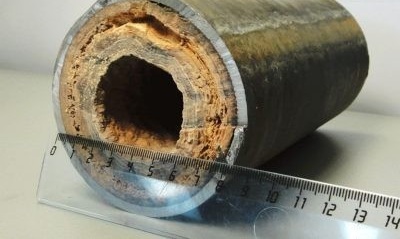
Such deposits in the central heating pipe indicate a strong contamination of the coolant with impurities - it is better not to use steel radiators in this case.
On sale you can find steel radiators of two types:
- tubular
- panel.
The advantages of the former come from a simple and reliable design that resembles a ladder made of parallel vertical tubes.
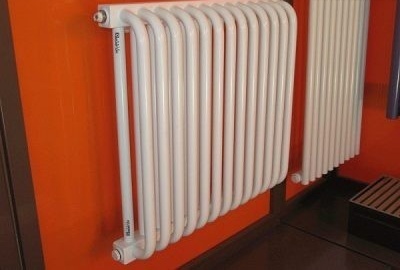
Tubular radiators are experiencing a second youth, being the object of attention of designers and lovers of modern trends in the interior.
Tubular radiators are more resistant to water hammer than panel ones. Their design allows you to implement any scheme of eyeliner and arbitrary placement in space. In the assortment of tubular batteries, there are both monolithic and sectional models from which you can easily assemble a battery of the required power. A simple manufacturing technology is reflected in an affordable cost, and the appearance of the radiator from a variety of vertical elements gives a wide field for design research. Unpretentious at first glance, tubular radiators are not so bad in business, if you write your opinion about it in the comments, we will discuss it with pleasure?
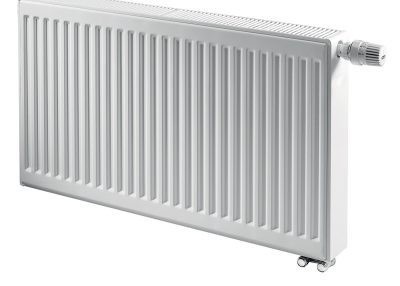
The flat, even surfaces of the panel radiators make maintenance much easier. That is why housewives love them so much.
For the manufacture of panel radiators, steel zigzag plates are used, which are welded to each other by spot welding. The cavities formed in this case serve as channels through which the coolant circulates. To increase heat transfer, manufacturers complicate the design by assembling a radiator from three panels. The flip side of this improvement is the weighting of the structure - the weight of multilayer steel heat exchangers is approaching cast iron.
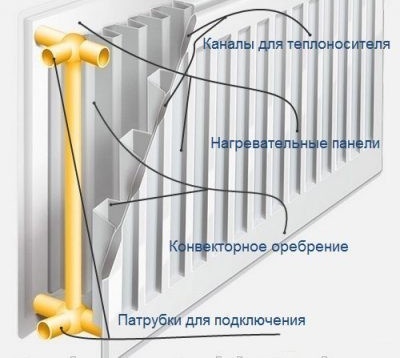
For the manufacture of a panel radiator, profile steel plates are used, the space between which acts as the water circuit of the heat exchanger
As you can see for yourself, such advantages of panel radiators as low price and attractive appearance are overshadowed by minuses in the form of low performance indicators. Most often, these heating devices are chosen for undemanding heating systems of a budget category.
Bimetal radiators
Bimetal radiator combines the high strength and durability of a steel heating register and the superior thermal performance of aluminum convectors.
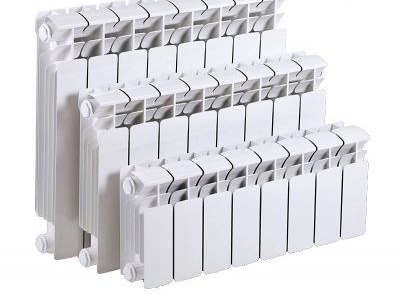
Bimetal radiators are indistinguishable from aluminum appliances, but have higher reliability and durability
The internal channels of the device are welded from seamless steel pipes, so that the battery can withstand pressure of more than 50 atmospheres and perfectly resists corrosion. An aluminum casing with convection ribs is fused to this skeleton. As a result of this trick, it is possible to obtain a product with maximum heat transfer, low heat inertia and a service life of up to 25 years.
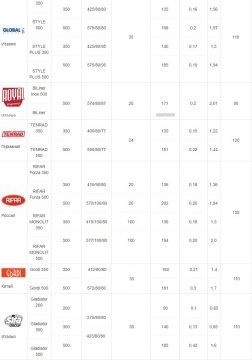
Technical characteristics of popular bimetallic radiators. The table is available in large sizes by click.
In addition to the monolithic bimetallic radiators described above, the industry also produces aluminum-steel heat exchangers assembled from separate sections. The composite battery loses an inseparable design in terms of reliability and durability, but it has advantages in the form of flexible adjustment of thermal power. All that is needed for this is to add or remove several additional sections. In addition, the indisputable advantage of type-setting bimetallic batteries is their high maintainability.
STOUT Space bimetal radiators combine ease of installation, no-frills aesthetics and a robust design that withstands pressures of more than 100 atmospheres. Products are manufactured at the largest Russian factory RIFAR and comply with GOST 31311-2005 "Heating appliances". The maximum heat carrier temperature is 135 ° C, the warranty from the manufacturer is 10 years, and the service life is 25 years. The available number of sections is from 4 to 14: bimetallic radiators can be installed both in a small kitchen and in the living room of a private house.
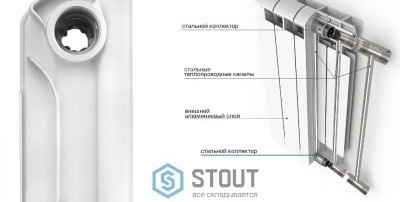
Sectional bimetal heating radiator STOUT. The steel heat exchange circuit and aluminum fins make the bimetal radiator extremely durable and efficient.
The available number of sections is from 4 to 14: bimetallic radiators can be installed both in a small kitchen and in the living room of a private house.
Making your choice in favor of the most technologically advanced of all existing radiators, do not let yourself be deceived. In order to save materials and reduce the price of the final product, manufacturers go to tricks. In some models, steel pipes are not made of a monolithic circuit, but only the vertical channels of the radiator. As for the horizontal working cavities, they are cast simultaneously with the aluminum body.
In the so-called "semi-bimetallic" batteries, steel plays a reinforcing role and does not have a positive effect on the service life. Recognizing the Light version is very simple - just “ring” a magnet with the individual parts of the heater.
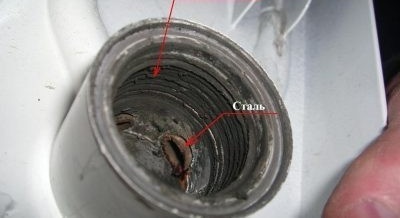
In semi-bimetal radiators, only vertical channels are made of steel, therefore, according to the criteria of reliability and durability, they do not differ from aluminum.
Copper radiators
Copper radiators compare favorably with other heaters in that their circuit is made of seamless copper pipe without the use of other metals.
About the features of working with copper pipes and fittings can be found in the article:https://aquatech.tomathouse.com/en/uchebnik/truby/mednye-truby-i-fitingi.html
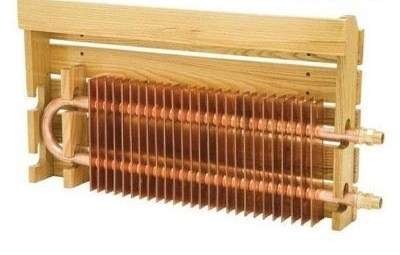
The appearance of copper radiators is suitable only for fans of industrial design, so manufacturers complete thermal appliances with decorative screens made of wood and other materials.
The pipe with a diameter of up to 28 mm is supplemented with copper or aluminum fins and decorative protection made of solid wood, thermoplastics or composite materials. This option provides effective heating of the room due to the unique heat transfer of non-ferrous metals. By the way, copper is more than 2 times ahead of aluminum in terms of thermal conductivity, and 5-6 times ahead of aluminum and steel and cast iron. Having a low inertia, the copper battery provides quick heating of the room and allows you to use thermostatic equipment.

In its thermal conductivity, copper is second only to silver, with a significant margin ahead of other metals
Copper's inherent ductility, corrosion resistance and ability to contact harmlessly with contaminated coolant without harm allows the use of copper batteries in high-rise apartment buildings. It is noteworthy that after 90 hours of operation, the inner surface of the copper radiator is covered with an oxide film, which further protects the heater from interaction with aggressive substances. There is only one drawback with copper radiators - too high a cost.

Comparative table of technical characteristics of copper and copper-aluminum radiators
Plastic radiators
At the moment, heating radiators made entirely of plastic, a kind of know-how.Including engineers are working on this type of heater. Contrary to popular belief, in terms of reliability, plastic radiators are close to metal products, and by such an indicator as corrosion resistance, they have no equal at all. Thermoplastic products have high mechanical strength, good thermal conductivity and wear resistance. Plastic radiators are not very heavy, so they are easy to transport and install.
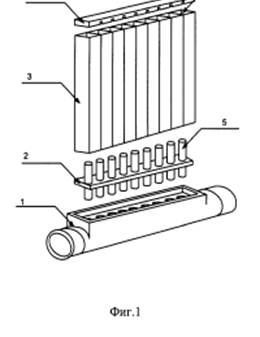
Plastic radiator circuit
For those who doubt the thermophysical properties of plastic, we recommend recalling the contours of heated water floors made of cross-linked polypropylene. Its thermal conductivity is lower than that of rigid thermoplastics, and, nevertheless, this does not prevent the use of plastic pipes to build reliable and efficient floor heating systems.
The simplicity of manufacture and, as a result, the low cost price make thermoplastics batteries an excellent offer for those who set themselves the task of saving. A significant minus of plastic heat exchangers is that they can only be used in systems with a stable pressure of up to 3 atm and a coolant temperature of no higher than 80 ° C. For this reason, the promotion of plastic batteries in our market is difficult.
Electric radiators
In addition to the heating devices discussed above, there are others - those that do not require a connection to the heating system. You probably already guessed that we are talking about electric radiators.
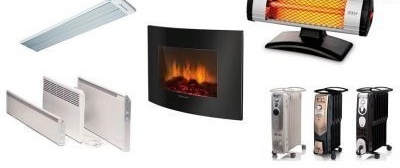
Modern electric radiators combine high efficiency, reliability and safety.
Depending on the design, several types of heat exchangers operating from the electric network can be distinguished:
- oil coolers;
- convectors;
- infrared devices.
The design of the oil cooler is most reminiscent of a traditional heating battery. Mineral oil is used as a heat carrier, and heating is carried out by a tubular electric heater (TEN). The closed design contributes to fire safety and mobility of the device, in addition, the oil heater does not burn oxygen and dust. The disadvantages include cumbersomeness, low efficiency and the ability to burn yourself when you touch a metal surface.
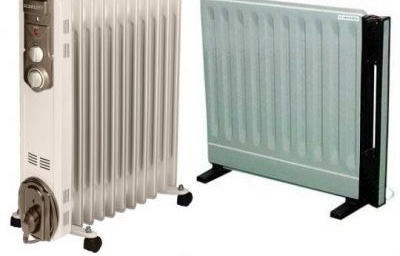
Oil radiators differ from traditional heating batteries in mobility - if necessary, they can be easily moved from place to place
Electric convectors also use heating due to ohmic losses, only in their design not air, but air heating elements are used. Thanks to the closed design, heaters of this type have the same advantages as oil radiators. As for the design, it is optimized so that the device uses convection as efficiently as possible. The disadvantages of the convector can be attributed only to low mobility - most often such devices are intended for stationary use.
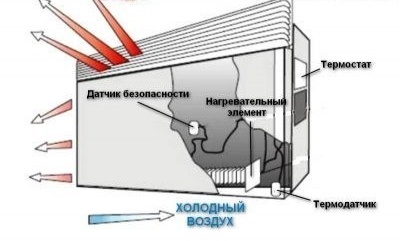
The simple design and convection heat transfer contribute to the reliability and efficiency of electric convectors
Infrared radiators are the most modern type of heating equipment. Unlike any other equipment, the principle of heat transfer by radiation is laid in their design.
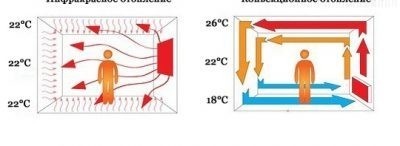
The principle of operation of infrared radiators is borrowed from the Sun - it is not the air in the room that is heated, but reflecting objects
By heating not air, but surrounding objects, IR heaters are highly efficient and at the same time have the highest efficiency. The disadvantages of devices operating similarly to the Sun can be attributed only to a relatively high cost.
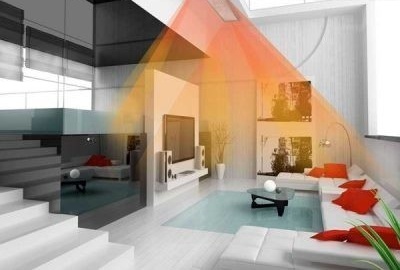
Unlike other radiators, infrared devices work most efficiently on the ceiling - in this case, radiation penetrates into the most remote corners of the room
How to determine the optimal radiator size
The dimensions of the radiator affect not only whether the heating device can heat the room to a comfortable temperature, but also on the efficiency of the heating system.
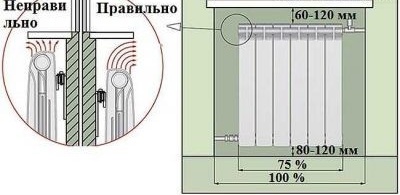
When determining the size of the heating battery, among other factors, the width of the window opening and the height of the window sill should be taken into account
The size of the battery is directly related to its thermal power, so the first thing to do is calculate the heat loss of the room. For this, the volume in cubic meters is multiplied by 41 W - the amount of heat required to heat 1 cubic meter. m of the structure, located in the middle latitudes. 20% should be added to the desired value - this margin will not be superfluous when extremely low temperatures occur. Knowing the cost of heat that will be needed to maintain a comfortable temperature in the room, you can choose a monolithic battery of the right size or count the number of sections of a modular radiator. In the latter case, the resulting figure should be divided by the power of one section.
When determining the number of sections of heating radiators, you can use the special table.
For rooms with non-standard ceilings, an oversized heating battery will be required. In this case, determine the number of sections of the radiator will help the table, taking into account the height of the ceilings.
It must be remembered that the radiator installed under the window must cover ¾ of the length of the window opening. In this case, the glasses will not accumulate cold air, and they will not fog up.
For those who do not want to engage in power calculation, our site has a convenient online calculator. All that is needed in this case is to enter the room parameters and heat transfer of one section of the selected radiator. The program will do all the necessary calculations for you.
General selection guidelines that everyone should know
Summarizing the comparative characteristics of various types of heating devices, we can distinguish the following main points:
- For a centralized open heating network present in high-rise buildings, like many years ago, a cast-iron radiator remains the best option. It is resistant to poor quality water circulating through our pipelines and will last for many years. "Accordion" will withstand pressure drops and water shocks, while effectively heating the air in the room. The small price of this type of heater makes it quite affordable for everyone. However, the high inertness of cast iron will not allow combining such a radiator with a thermostat.
- A good alternative to a cast-iron battery in multi-apartment buildings is bimetal based on steel with aluminum or copper. Steel has sufficient rigidity and corrosion resistance to withstand water hammer and the adverse chemical composition of water in the central system, while aluminum or copper compensates for not the most outstanding heat transfer of steel. However, the high cost does not allow us to say that this will be the best option.
- For closed heating systems present in private homes, it is usually easier to choose batteries - there is no overpressure in the heating system, and water is prepared before it gets into the pipeline. Therefore, the optimal type of heater for the home is aluminum. Its price is affordable, the design is good, the heat dissipation is high. Low inertness of this will allow it to be used in conjunction with a thermoregulation system.
- A good alternative to aluminum batteries in conditions of autonomous heat supply is steel radiators. Having lower heat dissipation than aluminum, steel heaters have many advantages - low weight, low inertia, nice design, attractive price.
- Steel and aluminum batteries are produced primed on the inner plane of the heating element to prevent corrosion from the aggressive medium. Dross and rust particles present in the coolant of open heating systems lead to mechanical destruction of the primer layer inside the appliances, so manufacturers recommend using them in closed heating systems of private houses. A good option for open centralized systems can be a copper radiator, but not everyone will appreciate its cost.
Video: how to choose heating batteries
That's all friends, I hope this information comes in handy when choosing a radiator, ask your questions in the comments and through the feedback form. With great pleasure I will answer them!
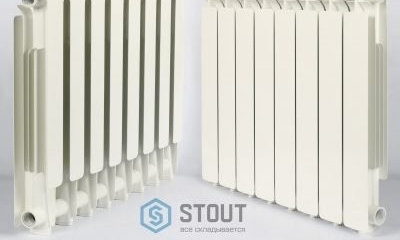
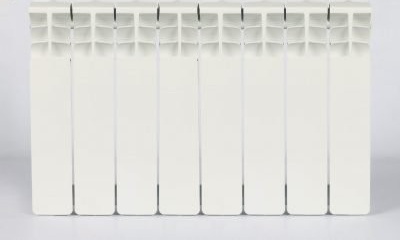

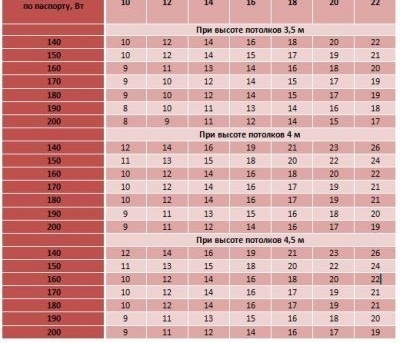

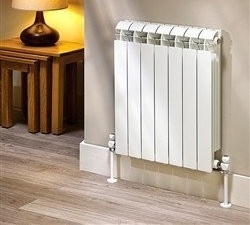
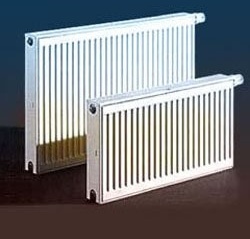
27 comments